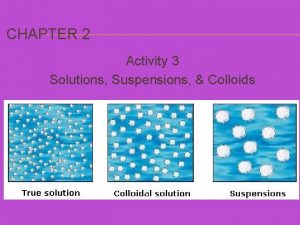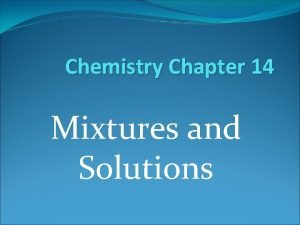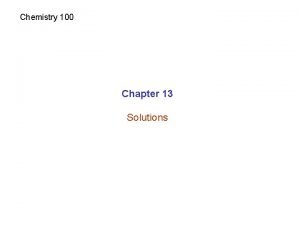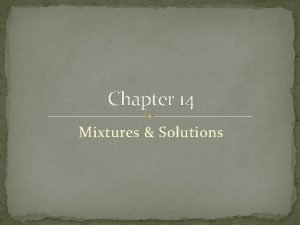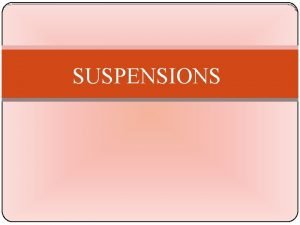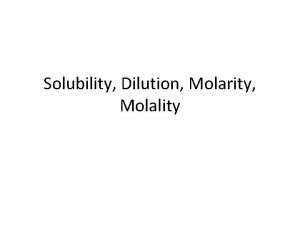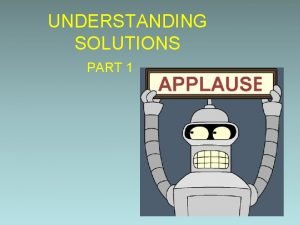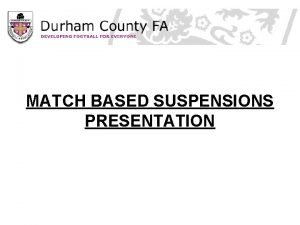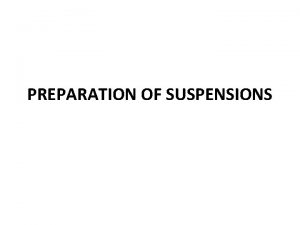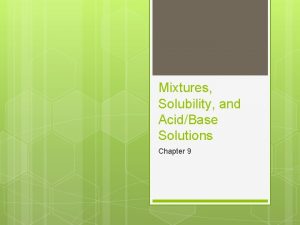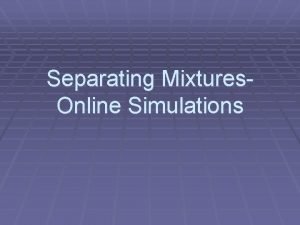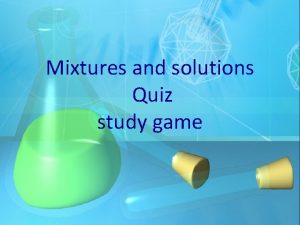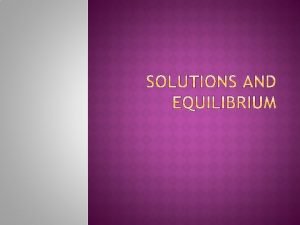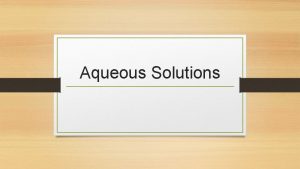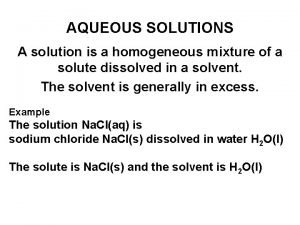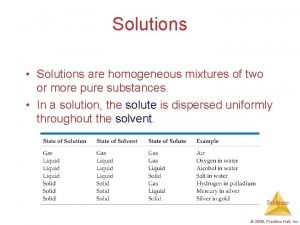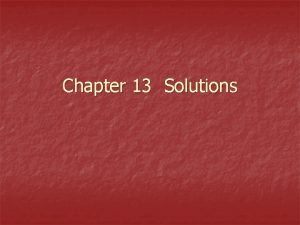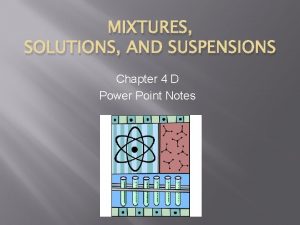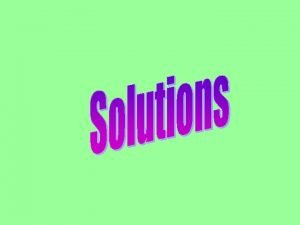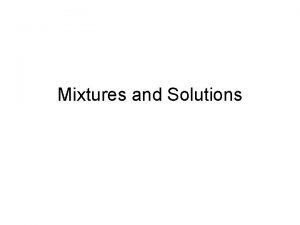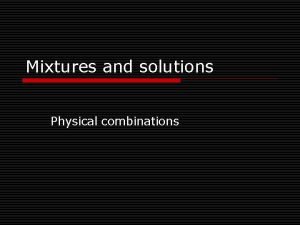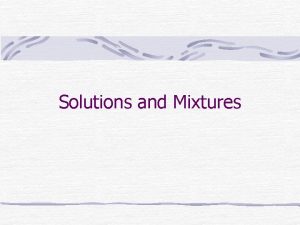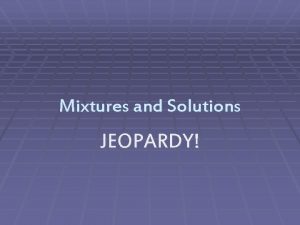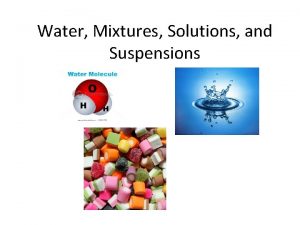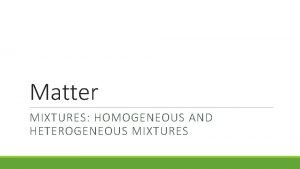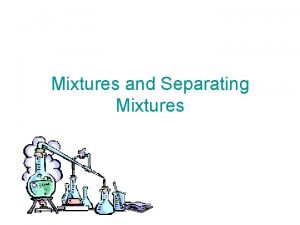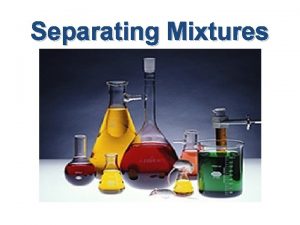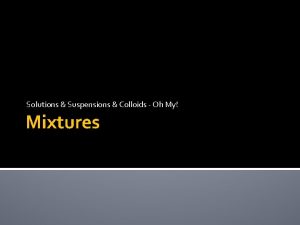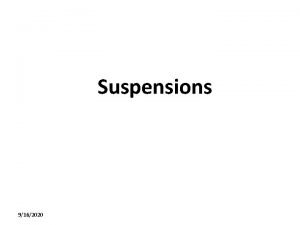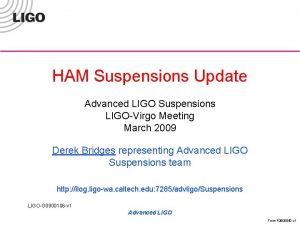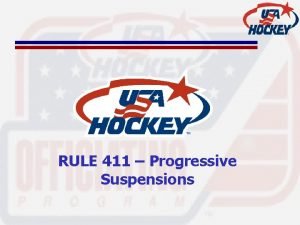MIXTURES SOLUTIONS AND SUSPENSIONS Chapter 4 D Power



















- Slides: 19

MIXTURES, SOLUTIONS, AND SUSPENSIONS Chapter 4 D Power Point Notes

Warm Up December 9 NEW WARM UP PAGE 18 1. 2. 3. What is solubility? What is the difference between a solute and a solvent? Provide one example for each. What does it mean if something is insoluble? Can you provide an example? Objectives: 8. p. 1. 1 -TSW understand the difference between a mixture and a solution. Essential Question: -What is the difference between a mixture and a solution?

Warm Up 1. 2. 3. December 9, 2014 What is the difference between a molecule and a compound? Give one example of a molecule and 1 example of a compound. What is the difference between a heterogeneous mixture and a homogeneous solution? Provide one example for each. Objectives: 8. P. 1. 1 -TSW understand the difference between a mixture, solution, and a suspension. Essential Questions: - What is the difference between a heterogeneous mixture and a homogeneous solution?

Discovery Education � www. discoveryeducation. com � Username: � student. IDnumber_CMS � Password: � Student. IDnumber

Warm UP 1. 2. December 7 What is a solution? Give one example of a physical change and 1 example of a chemical change.

Warm Up December 10 1. Describe a heterogeneous mixture. Provide an example 2. Describe a homogeneous mixture. Provide an example

Objectives � TSW understand Covalent and Ionic Bonds. � TSW understand the difference between heterogeneous and homogeneous mixtures.

Warm Up 1. 2. December 14 What is a covalent bond? What is an Ionic Bond?

Objectives �TSW understand the difference between covalent and ionic bonds. �TSW understand how covalent and ionic bonds form.

Solutions � A mixture is a combination of 2 or more substances. � Heterogeneous salad. � mixture is not the same throughout. Like a Homogeneous solution- a type of mixture that is the same throughout. � All portions of a solution are exactly the same. � Sugar dissolved in water is a solution � Sand water mixed up is not a solution. � Solute- a substance that is dissolved to make a solution. � Sugar � and Salt Solvent- A substance that dissolves a solute � Water

Solutions � � Types of Solutions �Solutes, solvents, and solutions can be solids, liquids or gases. �Example: CO 2 (gas) is dissolved in liquid to give pop carbonation. �Example : Sugar (solid) is dissolved in liquid to give pop its sweet taste. The solvent is the substance that is the greater amount. �Example: H 2 O Hydrogen is the Solvent because it is the greater amount 2 -H and 1 -O

Suspensions � Suspension- when the dissolved particle (solute) are larger than the solvent. �Instead of dissolving, the solute turns the liquid cloudy. Because they don’t fully dissolve. �Example: Add 1 table spoon of flour to a cup of water. What happens? �Some particles will settle out

Concentrations � � � Concentration- how much solute is dissolved in a solvent at a particular temperature. �Example: Well Water vs. Sea Water Dilute- low concentration �Example: small amount of sugar in water Saturated- high concentration �Maximum amount of solute dissolved in a solvent

Dilute vs Saturated

Solubility � � solubility- amount of solute that will dissolve in the solvent at a certain temperature insoluble- when one substance will not dissolve into another � Example: Oil and Water

Chemical Formulas � Chemical formulas- use chemical symbols to represent the atoms of the elements and their ratios in a chemical compound. � Subscript- a number written to the right of a chemical symbol. � CO 2

Mixtures, Solution, and Suspensions Sample 1 Sample 2 Sample 3 Sample 5 Sample 4

Venn Diagrams 6 facts per sections Mixtures 1 colored picture per section Solutions 6 facts per sections 1 colored picture per section

Pre/Post Activity Questions 1. 2. 3. 4. 5. What is a solution and why are solutions considered a homogeneous mixture? What is the difference between an mixture and a solution? What is a suspension? How are suspensions different from a heterogeneous mixture and a homogeneous solution? *USE YOUR BOOK TO COMPLETE THE QUESTIONS ABOVE!
 Solutions, suspensions and colloids activity
Solutions, suspensions and colloids activity Heterogeneous mixture def
Heterogeneous mixture def Chapter 13 solutions chemistry
Chapter 13 solutions chemistry Chapter 14 mixtures and solutions
Chapter 14 mixtures and solutions Evaluation parameters of suspension
Evaluation parameters of suspension Molarity
Molarity Is cake ingredients before blending a mixture or solution
Is cake ingredients before blending a mixture or solution Suspension mixture
Suspension mixture Durham fa suspensions
Durham fa suspensions Ingredients for suspensions
Ingredients for suspensions Mixtures solubility and acid/base solutions answer key
Mixtures solubility and acid/base solutions answer key Elements, compounds and mixtures worksheet answer
Elements, compounds and mixtures worksheet answer Fossweb mixtures and solutions
Fossweb mixtures and solutions Different types of mixtures
Different types of mixtures Mixtures and solutions quiz
Mixtures and solutions quiz Are all solutions homogeneous mixtures
Are all solutions homogeneous mixtures Are all aqueous solutions homogeneous
Are all aqueous solutions homogeneous Are all aqueous solutions homogeneous
Are all aqueous solutions homogeneous Solutions are homogeneous mixtures
Solutions are homogeneous mixtures Social sciences grade 6 term 2
Social sciences grade 6 term 2
